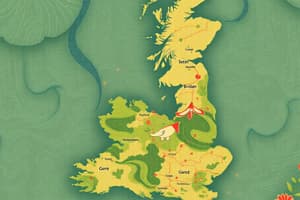Podcast
Questions and Answers
What is the primary factor that influences the formation of mountains?
What is the primary factor that influences the formation of mountains?
- Land use patterns
- Climate change
- Weathering and erosion
- Tectonic activity (correct)
What is the term used to describe the natural features of the Earth's surface that involve water?
What is the term used to describe the natural features of the Earth's surface that involve water?
- Waterforms (correct)
- Landforms
- Ecosystems
- Natural disasters
What is the process by which soil is removed from the land due to natural forces?
What is the process by which soil is removed from the land due to natural forces?
- Weathering
- Soil erosion (correct)
- Deposition
- Erosion
What is the location of the tallest mountain in the world?
What is the location of the tallest mountain in the world?
What is the factor that can influence the frequency and severity of natural disasters?
What is the factor that can influence the frequency and severity of natural disasters?
What is the term used to describe events such as earthquakes, hurricanes, and floods?
What is the term used to describe events such as earthquakes, hurricanes, and floods?
Which of the following factors does not influence climate?
Which of the following factors does not influence climate?
What is the term for the study of the Earth's natural features and processes?
What is the term for the study of the Earth's natural features and processes?
Which type of climate is characterized by high temperatures and high levels of precipitation?
Which type of climate is characterized by high temperatures and high levels of precipitation?
What is the process that shapes landforms such as mountains and valleys?
What is the process that shapes landforms such as mountains and valleys?
What is an example of a natural disaster that occurs on the ocean?
What is an example of a natural disaster that occurs on the ocean?
Flashcards are hidden until you start studying
Study Notes
Physical geography is the study of the Earth's natural features and processes, including climate, landforms, natural disasters, soil erosion, water forms, and the unique characteristics of mountains.
Climate
Climate refers to the long-term patterns of temperature, precipitation, and weather conditions in a particular region. It is influenced by factors such as latitude, altitude, proximity to large bodies of water, and prevailing wind patterns. Climates can be broadly classified into five main categories: tropical, dry, temperate, continental, and polar. The climate of a region plays a significant role in determining the types of vegetation, animal life, and human settlement patterns that are found there.
Landforms
Landforms are the natural features of the Earth's surface, such as mountains, valleys, plateaus, and plains. They are shaped by a variety of geological processes, including tectonic activity, erosion, and weathering. Landforms can have a significant impact on the climate, as they influence the distribution of heat and precipitation. For example, mountains can cause significant local climate changes due to the effects of orography.
Natural Disasters
Natural disasters are large-scale events that cause damage to the environment and can pose a threat to human life. Examples of natural disasters include earthquakes, tornadoes, hurricanes, and tsunamis. These events can be caused by a variety of factors, such as tectonic activity, atmospheric conditions, and the movement of large bodies of water. The frequency and severity of natural disasters can be influenced by the geography of a region, such as its location on a tectonic plate boundary or its exposure to storm surges.
Soil Erosion
Soil erosion is the process by which soil is removed from the land due to wind, water, or other natural forces. This can lead to the degradation of agricultural land and can pose a threat to human settlements. Soil erosion can be influenced by factors such as climate, land use patterns, and the type of soil present in the region.
Waterforms
Waterforms are the natural features of the Earth's surface that involve water, such as rivers, lakes, and wetlands. They play a crucial role in the Earth's ecosystems and can have a significant impact on the climate and the distribution of vegetation and animal life. Waterforms can be influenced by factors such as climate, topography, and the types of sediment present in the area.
Mountains
Mountains are large landforms that rise steeply above the surrounding terrain. They are often formed by tectonic activity and can be found in various locations around the world. The tallest mountain in the world is Mount Everest, which is located in the Himalayas. Mountains can have a significant impact on the climate and the distribution of vegetation and animal life, as their elevation and steep slopes create unique conditions for life.
In conclusion, physical geography is a complex and fascinating field that encompasses a wide range of natural features and processes. Understanding these features and processes is crucial for understanding the world around us and for making informed decisions about how to protect the environment and human settlements from the impact of natural disasters.
Studying That Suits You
Use AI to generate personalized quizzes and flashcards to suit your learning preferences.




